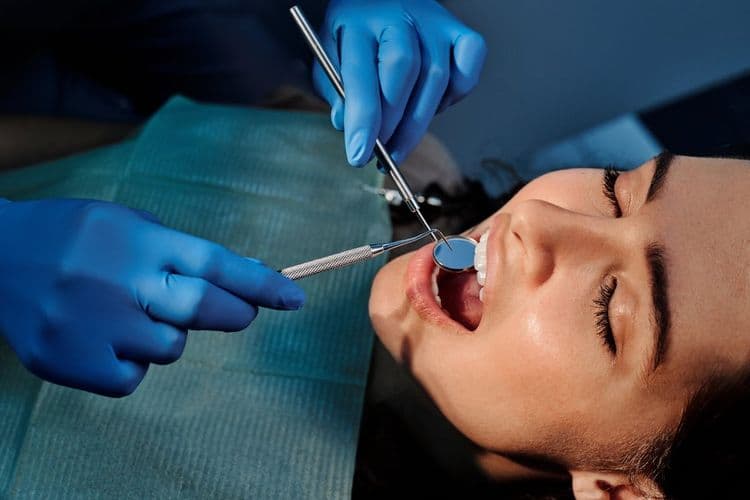The importance of post-operative care following a gingivectomy procedure cannot be overstated. Although the procedure itself may be straightforward, the subsequent care is vital to guarantee healing and reduce the risk of complications. This encompasses several aspects, from pain management and dietary adjustments to maintaining oral hygiene and identifying signs of potential concern. So, how can one navigate through this essential period effectively, minimizing discomfort and maximizing recovery? This discussion seeks to shed light on these questions and more, offering insights into the thorough care needed post-gingivectomy.
Understanding Gingivectomy Procedure
A gingivectomy, a common periodontal procedure, involves the removal of gum tissue, often to combat periodontal disease or to improve the aesthetics of a patient’s smile. This procedure offers several gingivectomy benefits, such as reducing pocket depth, aiding in dental hygiene, and enhancing smile aesthetics. It also helps in eliminating bacteria that contribute to periodontal disease, thereby promoting overall oral health. However, like any surgical procedure, there are gingivectomy risks. These may include postoperative discomfort, swelling, bleeding, and potential infection. There’s also a chance of gum recession, which can affect the appearance of the teeth and sensitivity to hot or cold. As a result, understanding these benefits and risks is vital in making an informed decision about undergoing a gingivectomy.
Immediate Aftercare Measures
Upon the completion of a gingivectomy, immediate aftercare is essential for recovery and prevention of complications. This includes strategies for post-procedure pain management, guidelines for maintaining oral hygiene, and necessary dietary adjustments. In the following section, we will discuss these aspects in detail to provide an extensive guide for effective post-gingivectomy care.
Post-Procedure Pain Management
Immediately following a gingivectomy, it is not uncommon for patients to experience some discomfort or pain as the local anesthesia wears off. To manage this post-procedure pain, there are several pain relief methods that can be employed. Over-the-counter pain medications, such as ibuprofen or acetaminophen, are typically recommended.
In more severe cases, your dentist may prescribe stronger painkillers. It is essential to use these medications as directed to avoid potential side effects. Alongside medication, it is vital to incorporate pain intensity tracking. Monitoring the level of discomfort will allow for adjustments in the pain management plan if necessary. Remember, sustained or escalating pain could indicate complications and should prompt immediate contact with your dental professional.
Proper Oral Hygiene Practice
Maintaining impeccable oral hygiene is paramount after a gingivectomy to prevent infections and promote healing. Appropriate flossing techniques and suitable mouthwash options play an essential role in maintaining oral health. Flossing helps in removing food particles and plaque from areas where a toothbrush cannot reach. It is advisable to use a soft, waxed floss to avoid irritating the gums. The correct flossing technique involves moving the floss gently up and down, following the curve of each tooth. Mouthwash, in addition to regular brushing and flossing, can aid in further reducing bacteria. Opt for mouthwashes containing chlorhexidine, known for its antibacterial properties. However, mouthwash should never substitute brushing or flossing, and always be the final step in your oral hygiene routine.
Dietary Adjustments Post-Gingivectomy
While recovery from a gingivectomy can vary from person to person, making dietary modifications during the immediate aftermath of the procedure is universally recommended to promote healing and prevent complications. A soft food diet is typically advised to avoid injury to the surgical site. Foods such as yogurt, mashed potatoes, and smoothies are excellent choices as they require minimal chewing. Avoid hot, spicy, or hard foods, as these can cause discomfort or damage to the healing gums. Hydration is equally essential for recovery. Drinking plenty of water helps cleanse the mouth and promote saliva production, which is crucial for oral health. However, remember to sip slowly and avoid using straws as the sucking action can disrupt the healing process.
Pain Management Techniques
Pain management following a gingivectomy is a critical aspect of patient care and recovery. Over-the-counter pain relievers often form the first line of defense, offering immediate relief in managing discomfort. Meanwhile, natural pain alleviation methods can provide supplementary aid, enhancing overall pain management strategies post-procedure.
Over-the-Counter Pain Relievers
Maneuvering the aftermath of a gingivectomy, patients frequently turn to over-the-counter pain relievers as an effective solution for discomfort management. These pain relief options, ranging from nonsteroidal anti-inflammatory drugs (NSAIDs) like ibuprofen to acetaminophen, offer temporary respite from post-operative discomfort. However, it is essential for patients to adhere to the medication guidelines, as excessive consumption can lead to unwanted side effects. Dosage instructions are typically based on a patient’s weight and age, and should not be exceeded. It’s also important to confirm that the chosen medication does not interact negatively with any prescribed drugs. For best relief, patients should consult with their healthcare provider regarding suitable over-the-counter pain relievers in the context of their overall post gingivectomy care.

Natural Pain Alleviation Methods
Although a gingivectomy is a routine dental procedure, post-operative discomfort can persist, necessitating effective pain management strategies. One such approach is the use of natural pain alleviation methods. Herbal remedies, for instance, have been used for centuries to manage pain and inflammation. Certain herbs, like turmeric and ginger, possess anti-inflammatory properties that can aid in reducing gum swelling and pain. Essential oils, too, play a significant role in pain management. Peppermint and clove oils are particularly beneficial due to their analgesic and anti-inflammatory properties. However, these natural remedies should be used with caution and under professional guidance to avoid any potential side effects or interactions with other medications.
Nutritional Recommendations
A significant part of recovering from a gingivectomy is adhering to specific dietary guidelines designed to promote healing and prevent complications. In the days following the surgery, soft food options should form the core of your diet. Foods like yogurt, mashed potatoes, eggs, and smoothies are nutritious and require minimal chewing, reducing the chance of irritating the surgical site. Equally important is maintaining adequate hydration. Hydration tips include drinking plenty of fluids, especially water, and avoiding alcohol, caffeine, and acidic drinks which can exacerbate oral discomfort. Hydrating well assists in maintaining saliva production, an essential part of oral health. These nutritional recommendations are a key aspect of recovery, helping to guarantee an ideal healing process after a gingivectomy.
Oral Hygiene Post-Gingivectomy
While recovering from a gingivectomy, maintaining proper oral hygiene becomes paramount to prevent infections and promote healing. Practicing good oral care not only aids the healing process but also limits the potential for further dental issues.
Here are a few essential steps to follow: - Regular Rinsing: Use a prescribed antibacterial mouthwash to keep the mouth clean. - Gentle Brushing: Brush gently around the surgical area to avoid disrupting the healing process. - Healthy Diet: Consuming a nutritious diet helps in healing and maintaining overall oral health.
Possible Complications to Watch For
In the process of recovery, one must be vigilant about possible complications that could arise after a gingivectomy. Infection prevention is paramount; any signs of persistent swelling, redness, or pus should not be overlooked. These could indicate an infection that requires immediate medical attention. Pain that exceeds normal post-operative discomfort or pain that intensifies over time may also be a sign of complications. Unusual bleeding, beyond the typical healing timeline, could be symptomatic of an issue that needs intervention. Additionally, if you notice any loosening or shifting of teeth, this may suggest a healing problem. Remember, early detection of these potential complications can greatly enhance the success of your recovery and overall gingivectomy experience.
Importance of Follow-Up Appointments
Given the potential for complications after a gingivectomy, follow-up appointments play a critical role in ensuring a successful recovery. The follow up significance lies in early detection and management of any post-operative issues, thereby reducing the risk of further complications.
Appointment scheduling should be taken seriously, as consistency is key. Regular appointments allow your dental professional to:
- Continually assess the healing process and make necessary adjustments to your care plan.
- Monitor for any signs of infection or complications that may arise.
- Provide guidance on maintaining ideal oral health post-procedure.
Tips for Long-Term Oral Health
After undergoing a gingivectomy, adhering to a robust and regular oral hygiene routine is vital for maintaining long-term oral health. This not only guarantees the successful healing of your gums post-surgery but also maximizes the long-term benefits of the procedure. Good oral health habits such as regular brushing, flossing, and rinsing with antibacterial mouthwash are essential. Regular dental check-ups allow for early detection and treatment of potential issues, thereby enhancing oral health. Incorporating a healthy diet also contributes considerably to long-term oral health by providing necessary nutrients for gum tissue health. Ultimately, a proactive approach to post gingivectomy care has a notable positive impact on your oral health and overall wellbeing.
Frequently Asked Questions
Does Insurance Typically Cover the Cost of a Gingivectomy?
Insurance coverage for dental procedures like a gingivectomy varies widely. Most insurance plans partially cover periodontal treatments, but the extent depends on the specific policy. Consult with your insurance provider for detailed coverage information.
How Long Does the Full Recovery Process Take Post-Gingivectomy?
The full recovery process post-gingivectomy typically spans 2-3 weeks. This recovery timeline can vary based on individual health factors. Proper oral hygiene can expedite the healing process, ensuring a swift and complication-free recovery.
Can I Continue to Smoke or Drink Alcohol After a Gingivectomy?
After a gingivectomy, it’s advisable to avoid both smoking and alcohol consumption. Smoking effects include impaired healing, while alcohol’s impact can cause irritation and delay recovery. Always prioritize oral health for a successful recovery.
What Types of Medication Will I Need to Take After the Procedure?
Post-procedure medications typically include pain management drugs and antibiotics. Ideal oral hygiene is essential, so a special mouthwash may also be prescribed to prevent infection and promote healing in the surgical area.
Are There Any Activities or Exercises I Should Avoid During the Recovery Period?
During the recovery period, it is advisable to avoid strenuous activities to assist in swelling management. Additionally, diet modifications are necessary; hard, crunchy, or spicy foods should be avoided to prevent irritation or damage.


